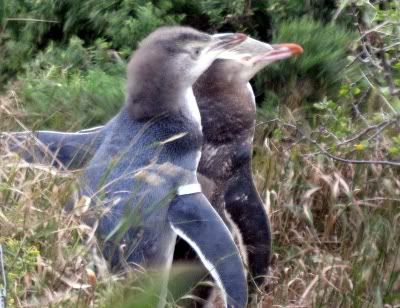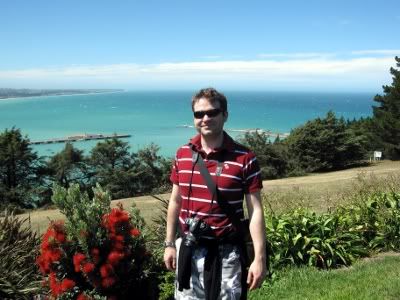
We headed back round the harbour for breakfast today, for eggs on toast. Mine quickly became egg on toast when I lowered my defences to get some pepper from a neighbouring table and a gang of seagulls swooped down and gobbled up an entire poached egg and most of a piece of toast. Their leader – an ugly and noisy old thing – had been scoping us out from a tall flag pole the moment we'd turned up. I now have only one rule about seagulls: Kill them, if you can.
We had to leave Akaroa today, just two nights after falling in love with it. The landscape changed significantly as we left the Banks Peninsula and joined the main road south, with the wild and rugged becoming tame and flat – somewhat like Kent without the oast houses. The road was a single carriageway most of the way, and despite being the only trunk road on the east side of the island the traffic was very quiet and fast moving.
Around 1pm we arrived in Timaru for lunch. We had originally planned to stay in Timaru, but today we were very glad we had not. Timaru had all the look of an antipodean Blackpool, and although it had apparently seen glory days as a seaside town they were clearly long behind it. We stuffed a sandwich down our throats outside the tourist information centre (which, judging from its information boards, only specialised in helping people get the hell out of Timaru) and headed for our final destination for the day: Oamaru.

Oamaru looks less like a seaside town whose glory days are behind it, and rather more like Harrogate after global thermonuclear war (the guidebook is more euphemistic, suggesting it is merely “slowly gentrifying”). Apparently once the most attractive city on South Island, the town centre is now a rag-tag collection of Victorian buildings – including our own Empire Hotel Backpackers Hostel, a grand stone building with a neoclassical façade – distributed in between ugly or abandoned buildings, warehouses and factories, with many of the 'classical' buildings now bricked up and used as storage facilities. We should have guessed something was up as we drove down the main drag and passed no fewer than five separate people making their way into town in electric wheelchairs. This is not a hip and happening city.
Of course, none of this mattered as we had only come to Oamaru to see yellow-eyed penguins. We checked into our hostel and walked 5km uphill to a look-out point over the bay, then crested the hill and strolled down a remote country path to the far side of the coastline, where the yellow-eyed penguins live. These are a special, non-migratory and large form of penguin which are relatively unique to the area. We were told that one must be extremely patient if one wishes to see them and – as we're not very patient – we instead killed some time walking back into town for a spot of dinner at The Last Post, took at 90 minute nap and then drove back up to the colony to see if the penguins were up to much yet.

The lady in the tourist information office had warned us that we might not see any penguins at all (they are entirely wild, living on a beach completely naturally, so there's no charge to visit them and no guarantees). Fortunately, as we turned up (at 8pm) there was already a brave penguin strolling around on the beach, in the company of two giant brown seals. As the sun gradually set over the next hour, the penguins became more active and two more penguins appeared down on the beach. It was hard to make out much more than that as we were viewing the birds from a special walkway built high on the top of the cliffs above the bay, and as one American woman exclaimed “they're microscopic!”.
We had imagined that would be about it. Much to our surprise, however, a mother and her baby penguin suddenly appeared about a metre from the fence, high up the cliff wall among the shrubbery, where they politely posed for photographs (although they were visibly scared when flashes went off, something the volunteer attendant demanded we should not do and which – all the same – was a request various idiot tourists were unable to comply with). We were surprised to see them so high up the cliff, but it seems the penguins have made long winding pathways through the cliff-side shrubs and simply walk up from the beach to their cliff-top nests when they're ready for bed. These two were joined by another adult penguin, who posed briefly in front of the hide before shuffling off into the undergrowth with a nonchalant wave of one wing, as though to proclaim “Get out of my way, I'm fabulous!”.

After that, once we knew where to look, a few more penguins appeared in the undergrowth. As the wind raged and the sun began to set, the viewing platform emptied out and we were soon the last ones there. Although yet more penguins were now coming out of their nests for fresh air, we figured we should perhaps leave them with some peace and quiet.
It is a shame really that we were the last to leave, as our car refused to start and there was no one to give us a lift back into town (where I had conveniently left the AA phone number). We therefore enjoyed the walk back into town all over again and – since the AA refused to pick us up from the centre of town – we also got the wonderful opportunity to enjoy a second stroll up to the penguin colony, this time in pitch black and a howling gale.
We sat for some time in the car waiting for the AA – listening to disco tunes on the radio, and trying the engine periodically and without luck – until it was over an hour since we'd phoned for help. I tried the engine one last time and – dumb luck – it randomly fired up, so we drove back to our hotel and went in search of a recuperative drink. Alas, The Last Post was closed by 11pm, and the only other nightlife we had seen during our travels (on this, a Saturday night) was an octogenarian woman hobbling out of a disco at the Scottish Hall, a middle-aged man on each arm. We decided to wait until Queenstown for our drink and called it a night.
Update: Whoops. It seems pressing the accelerator when starting such a modern car as a Ford Focus means the engine can't fire up. I had assumed all cars were the same as my own, a 1971 wreck that typically needed more acceleration than I could provide to start. This was a lesson learned the hard way...




Seagulls are just screams dressed up in feathers ... or is that drag queens?
ReplyDelete